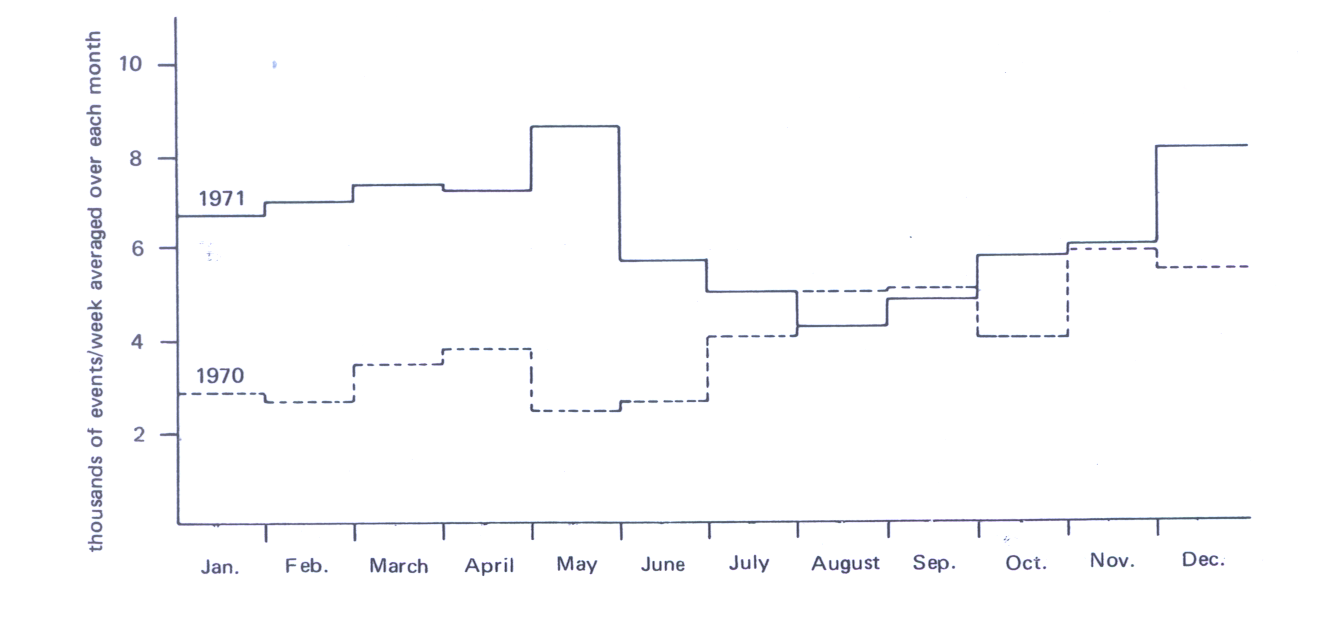

On 10th November 1970 approval was given for the purchase of a new central computer, an IBM Model 360/195, at a total cost of £3.6 million. Preparation for the installation went on throughout the year, and the machine was accepted on 15th November 1971 (six weeks ahead of the original schedule). To maintain an uninterrupted computing service the IBM 360/75 was kept in use (though with reduced peripheral equipment) during the transition period. Some batch work was immediately transferred to the new machine on its acceptance, tests with on-line equipment began, and HPDI was brought back into service on the evening of 15th November, after a break of 137 hours.
Other on-line developments, previously reported on, have reached fruition during the year. Some have accordingly been designated as public services, and become the responsibility of the Computer Manager. In this category are the terminal IBM 1130 (situated in Hall 3), the Remote Job Entry work-stations operating under HASP at Birmingham, London (Institute of Computer Science) and Oxford, the six IBM 2741 typewriters (situated in Building R1), the Computek visual display system (in R1) and the ELECTRIC software system. The Computek system in Building R25 (like the IDI display with light pen) has reached a similar state but is a private group facility, while other terminals are still under development.
The Computing Centre extends its service on 1st January 1972 to all members of the Nuclear Physics community (Counter, Film Analysis, Nuclear Structure and Theory) and to research workers in other fields selected by the ATLAS Laboratory. The fraction of time allocated to each category will be reviewed regularly by the Advisory Committee.
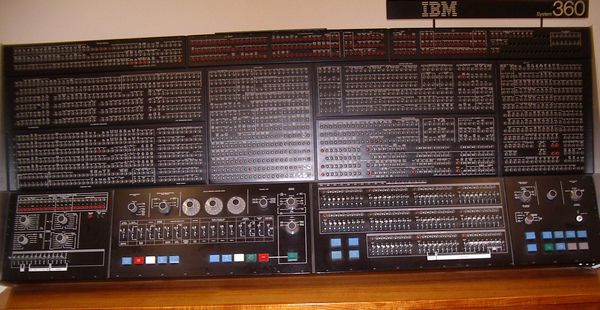
During the year several changes were made to the operating system under which the model 75 ran, in order to cope with the heavy load of production work, allow for the attachment of new devices, and to prepare for the installation of the model 195 as a replacement machine.
Since first installed, the model 75 had run under the MFT option of the Operating System (Multiprogramming with a Fixed number of Tasks). In many ways this was well suited to the Laboratory's work: there were many very long-lived jobs (the control programs of on-line devices) which had to operate in defined regions of memory, and MFT was the only variant of the system which allowed exploiting of the Large Core Store of 8 μs memory.
With Release 19 of the Operating System early in 1971, MVT (Multiprogramming with a Variable number of Tasks) became capable of controlling the LCS, but there still remained the problem of causing long-lived programs to be loaded into chosen locations. This was solved by writing code (collectively known as FENCE) which caused part of the machine to have dedicated partitions (as with MFT) while the remainder of memory was administered by MVT.
Thus we combined the benefits of MFT for very long jobs with the advantages of MVT for processing the batch-stream. It was expected that small quick jobs would benefit from MVT, and that MVT would be the preferred version of the Operating System for the model 195.
Unlike MFT, the MVT option did not supply the programmer with an indicative Diagnostics dump in the event of abnormal job-end, so a substitute (but optional) routine PITFAL was written to give substantially equivalent facilities. Conventions also had to be designed for ensuring that logically interdependent jobs be run in the correct time-order.
By modifying a component of the Fortran library it was found possible to mitigate the consequences to programmers of one of the features of the 195 central processor, viz overlapped execution of several instructions (imprecise interrupts).
MVT entailed the abandonment of IBM(UK)'s MUSIC method (Machine Utilization Statistical Information Collector) of recording use of machine resources. Instead the IBM System Management Facility (SMF) had to be introduced and exploited in such a way as to produce the same statistical reports as before.
It was known that release 20 of the Operating System would be the first to support the model 195; also that the revision of HASP (Houston Automatic SPOOLing Program; SPOOL: Simultaneous Peripheral Operations On-Line) known as HASP2 Version 3 contained many good features, especially for the attachment of remote work-stations.
To provide early experience, Release 20 was implemented on the model 75 towards the end of its life here. This version gave a great deal of trouble for a few weeks but eventually corrections were found which restored reliability. During the year the practice was introduced of using new systems for a few short periods before establishing them as new standards, with the objects of familiarizing both operators and users with any new features, and of detecting any faults not revealed by the standard batch of test programs.
Release 20.0 was used for the model 195 acceptance tests on November 15th. Trials of the test-batch were completed by about 1600 hours, and the on-line system became operational during the evening.
In December yet another version of the operating system was introduced, release 20.1; this supports the Block Multiplexor Channel which will connect the central processor with the new Fixed-Head File and the large-capacity disks which are expected to be available in January 1972. This version gave no trouble.
Throughout the year we have retained as standard the Fortran compilers and library associated with release 18.6. The Fortran components of release 20 are however available if wanted, and may become standard early in 1972.
Long-term studies have been initiated of a new optional feature of the Operating System known as TSO - the Time-Sharing Option - which would enable terminal users to create and edit stored files, and to initiate programs which would either run interactively with the terminal, or join the standard queues of jobs for the batch-stream.
Our objective is to establish methods of benefiting from the time-shared method of using the machine without losing the advantages of the locally developed ELECTRIC subsystem of interactive file-handling, and the well-established MAST/ DAEDALUS programs which support ELECTRIC as well as the on-line devices HPD I, HPD II, Cyclops and the interactive IDI display.
Extensions have been made to MAST so the ELECTRIC (and MAST) facilities are available at terminals (IBM 2741's and other manufacturers' equipment) which are connected directly to the central machine via an IBM 2702 teleprocessing controller (instead of through the satellite computers which were the original basis of MAST).
In order to improve job turn-round, to increase operational efficiency, and to monitor use of the machine more dynamically, much work has been done on methods of scheduling jobs which require magnetic tapes or private disk-packs to be mounted (set-up jobs), and of relating (should need arise) the priorities of jobs to allocations of machine-time. These additions to the system have not yet been implemented.
Figure 118(a) and 118(b) show the weekly totals of batch jobs processed and the averages (per week) or central computer efficiency ie, (scheduled - downtime) / scheduled time and CPU utilisation i.e. CPU time used / (scheduled - downtime). The totals of batch Jobs processed were 145,000 on the 360/75 (from 1/1/71 to 17/11/71) and 20,000 on the 360/195 (from 15/11/71 to 1/12/71).
Little or no change was required in most user programs when the 360/195 came into operation: the upwards compatibility of the 360 series paid off well. Commissioning of the new central computer, and of the remote and local on-line facilities, was quick and virtually trouble-free. The CPU time used by programs fell by a factor of about 5 from the 360/75. In the short time it has been here, the reliability and operation of the 360/195 have been very encouraging.
During the year three remote work-stations have become fully operational. They Work Stations are at Birmingham University (IBM 360/44), Oxford University (IBM 2780) and the Institute of Computer Science in London (PDP9). Job entry and output retrieval is possible at each station. At Oxford, the station is used for some 35 hours and 400 jobs per week. The London group, running jobs with an average of about 5000 lines of output, are sometimes limited by the link speed, and average 30 jobs in 12½ hours/week.

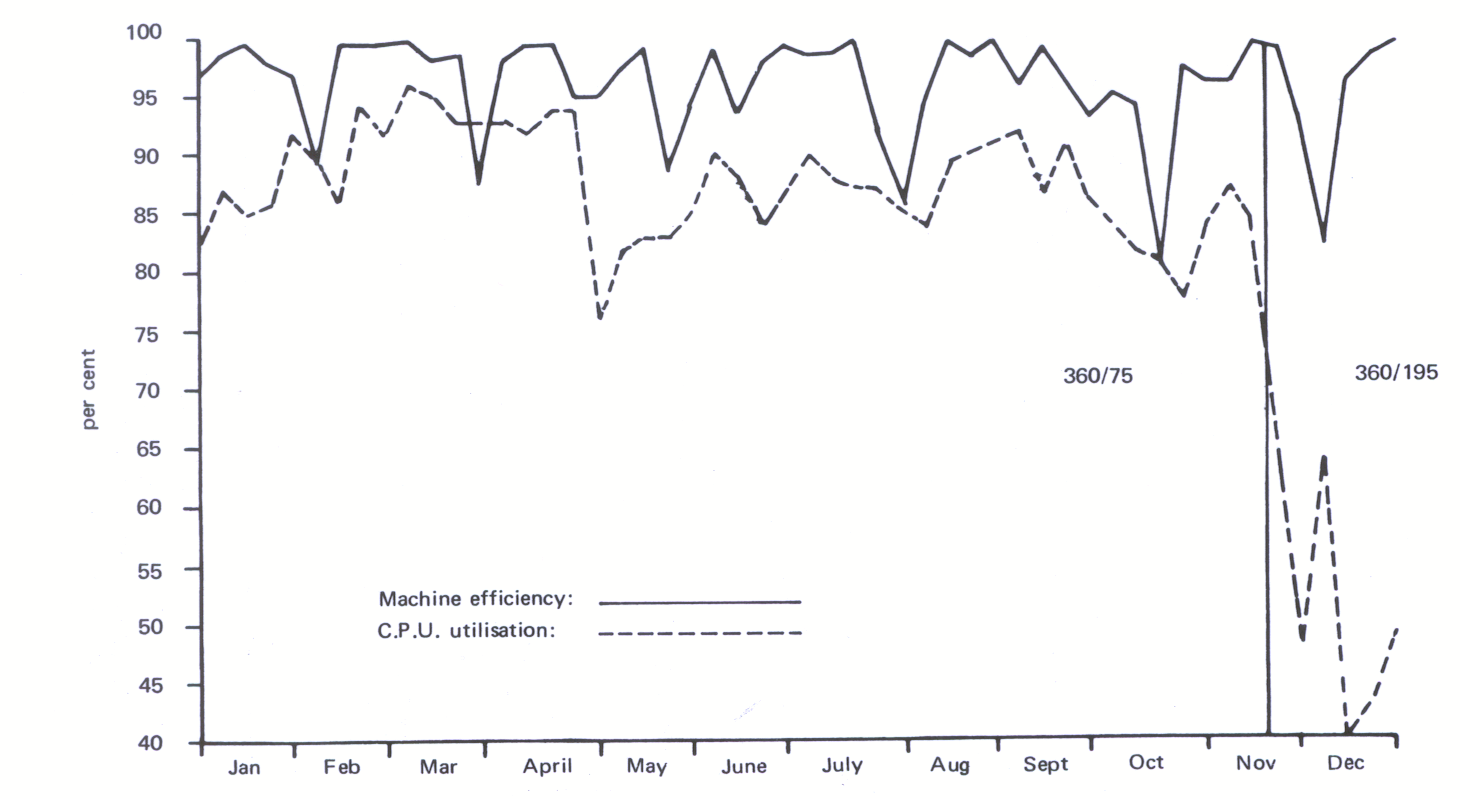
The ELECTRIC job submission and file-handling system has come into full use, as a public service, during the year. About 60 programmers actively used the system, and 15-20% of all jobs are now submitted from terminals. Some statistics of ELECTRIC use appear in Figure 119. There are in the Laboratory six public keyboard terminals (IBM type 2741) available for using ELECTRIC and nearly a dozen others (mainly IBM type 735 'golfball' typewriters) which are not all publicly available. Developments under way will allow external users similar facilities via GPO telephone lines, including use of remote displays.
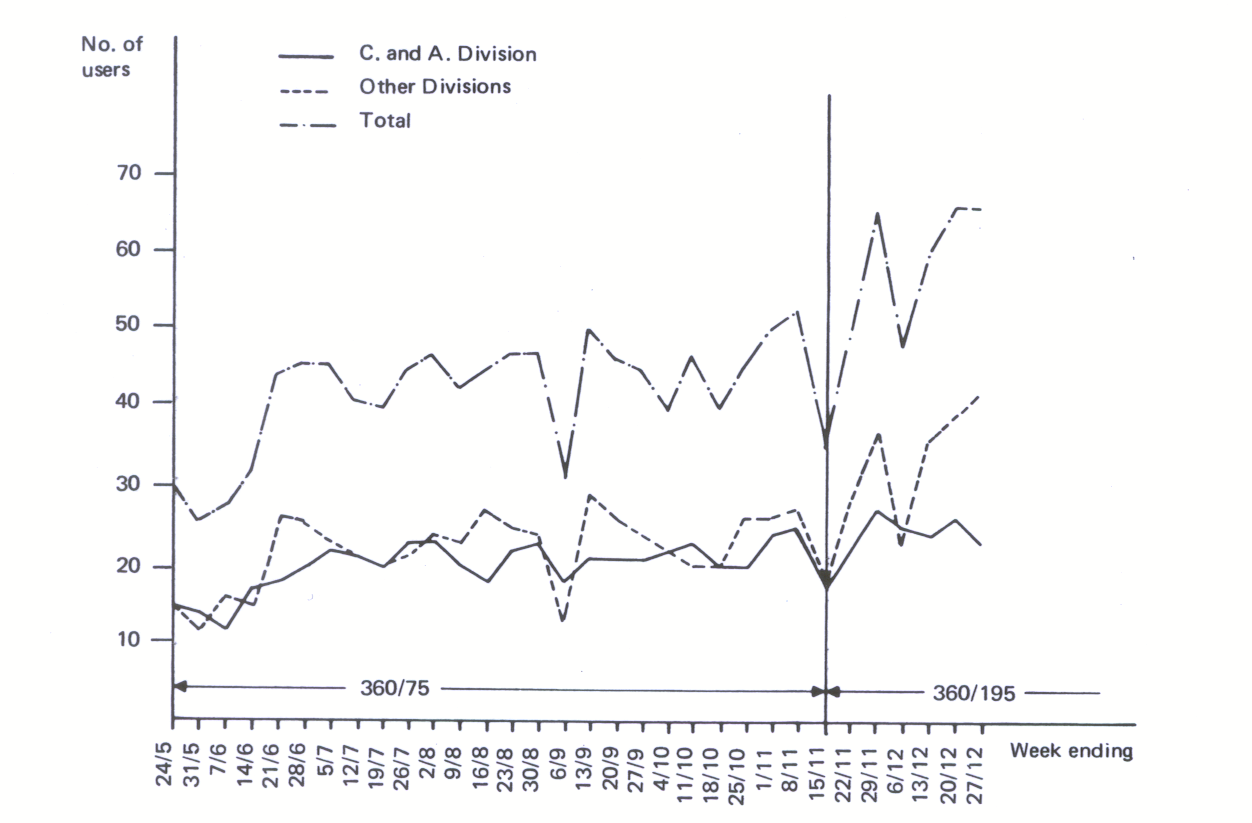
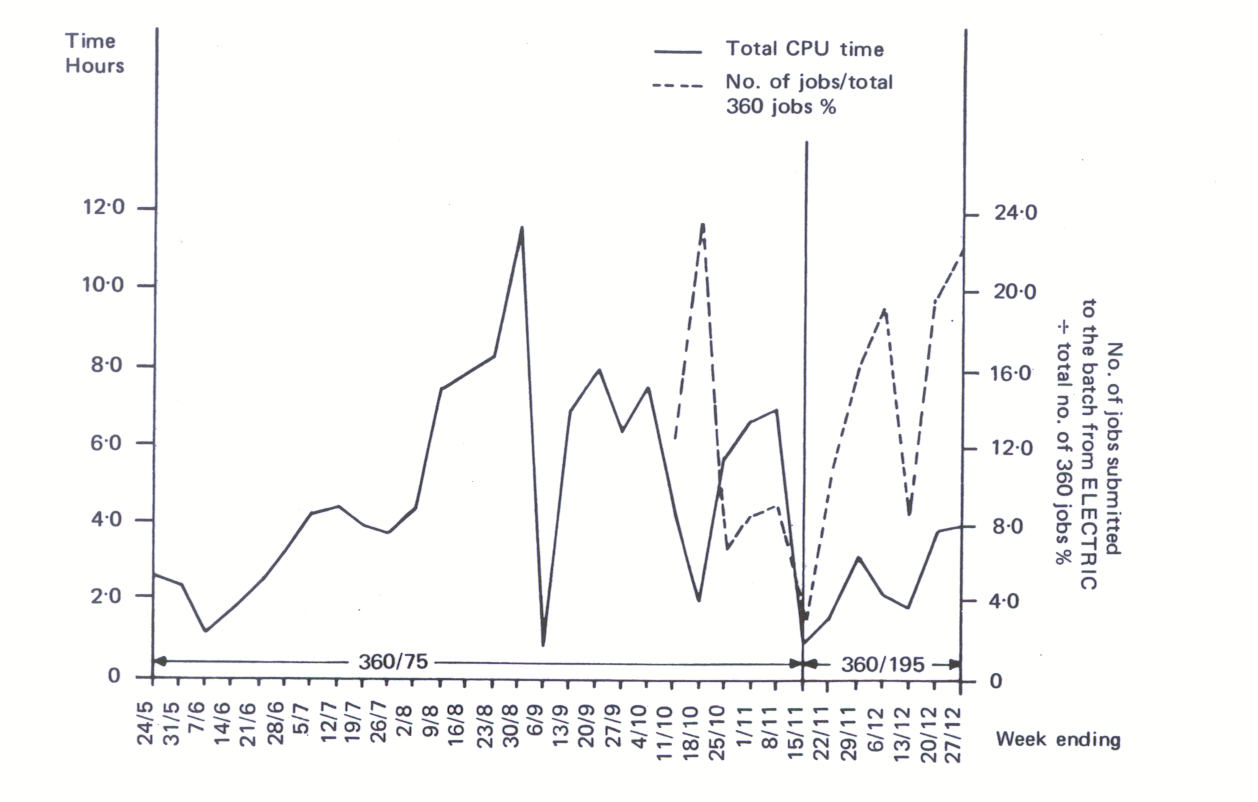
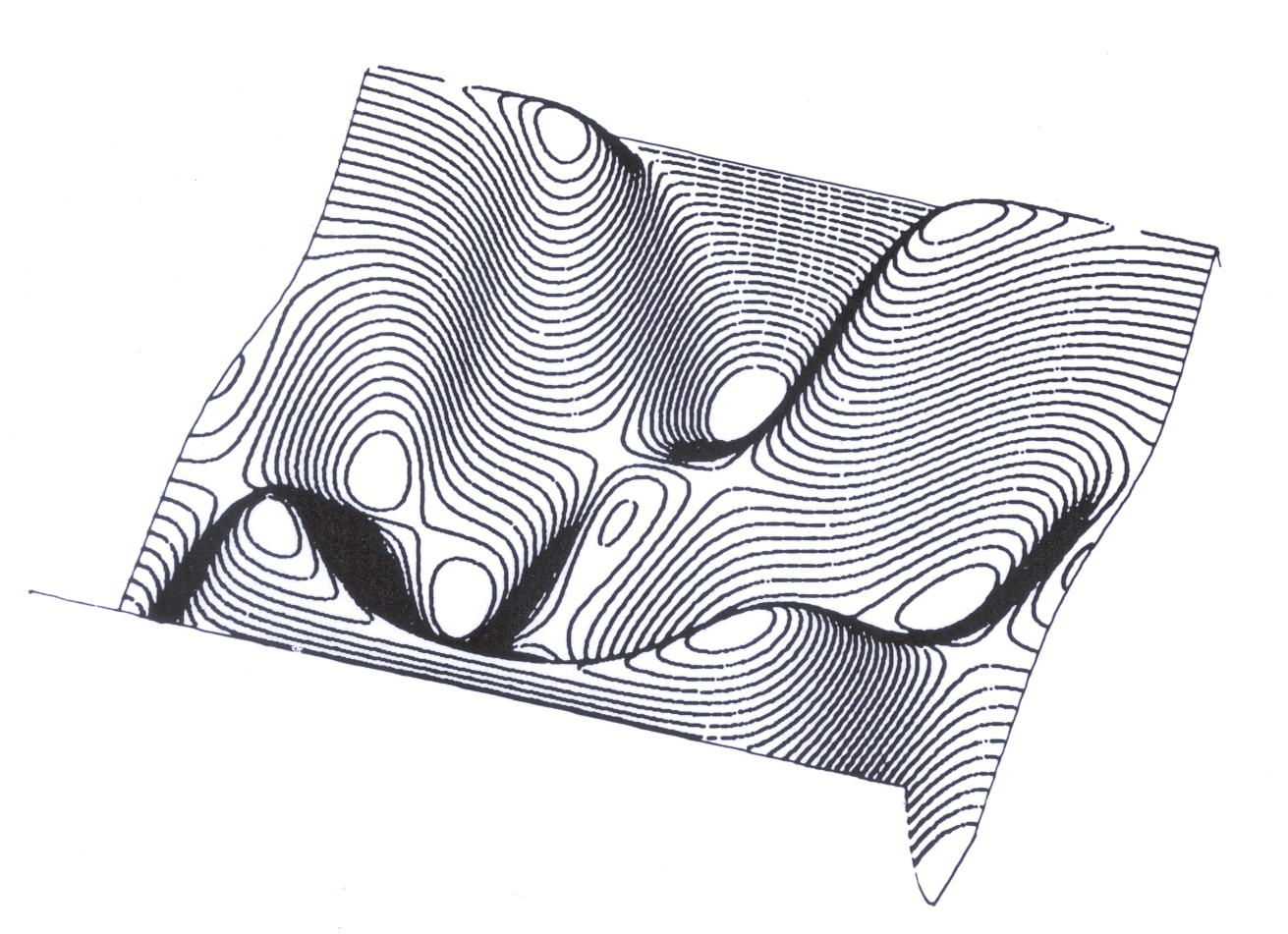
The graphics file retrieval facilities in ELECTRIC have some 60 users, of whom about 20 are normally active in any week. Edited line printer output from batch jobs can be filed, allowing remote selective examination on any typewriter, Visual Display Unit or other display attached to the system. About 30 of the 180 graphics files held at the year-end are of this type. The graphics software has been extended to include drawing of histograms, logarithmic and three-dimensional plots (see Figure 120). Rarely used files may now be archived to tape.
A second Computek 400, stationed in Building R25, has been attached to the system. It is used by the Applied Physics Division both for line-printer and graphics file retrieval, and interactively for magnet design.
The Terminal IBM 1130 is situated in Hall 3 and provides experimenters in the area with a direct link to the Central Computer. Users can submit jobs or data (on cards or 7 track magnetic tape) and receive output on an 80 lines/minute line printer. It is also possible to communicate with ELECTRIC via the console type- writer. Communication between the two computers is via an 880 kbit/sec serial link. Further developments (described later) will allow another sixteen devices to be linked to the terminal computer.
As already mentioned, the IBM 360/195 will be available to many users outside the Rutherford Laboratory from 1 January 1972. Some 20 University Nuclear Physics groups have requested computing time. To assist this increased number to utilise the computing system effectively, a User Support section has been set up. Some of its functions during the year are described below, while new and extended activities are expected next year, particularly in education, technical assistance and program library facilities.
Program advisers have been available daily from late September, to deal with queries regarding Job Control Language, Fortran and Assembler coding. Towards the year end, the main task was to introduce new (external) users to the system. Detailed technical assistance was provided for several projects, in particular for the Queen Mary College/Liverpool/Daresbury/Rutherford experiment (S99) and to the Finance section of the Laboratory.
The User Support section intends to provide effective liaison between each user and the central computer organisation. For this purpose each user group has been asked to appoint a representative who has an overall idea of the computing work within the group. This will ensure that every user has at least a formal line of communication to the central organisation.
A watch has been kept on the weekly accounts of computer usage. The User Support section was involved in the voluntary restraint introduced for a very busy period in early summer, and will participate actively in the new accounting system to be introduced next year.
Assistance was given in producing the second issue of CIGAR (Computer Introductory Guide And Reference), the Computing and Automation Division's Quarterly Reports, the Introduction to Central Computer Facilities and numerous bulletins and reports.
A fortnightly series Seminars on Computing was arranged, concentrating during 1971 on on-line computing. Two courses of lectures were organised, one on ASSEMBLER language, the other on the ELECTRIC system. Each course was attended by about 50 persons. The program libraries have been extended during the year, and a full list appears in CIGAR.
